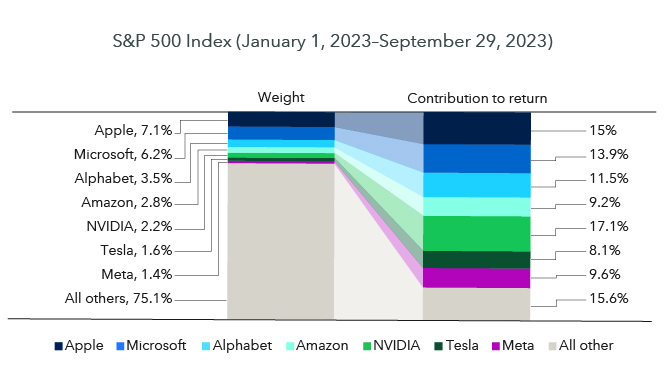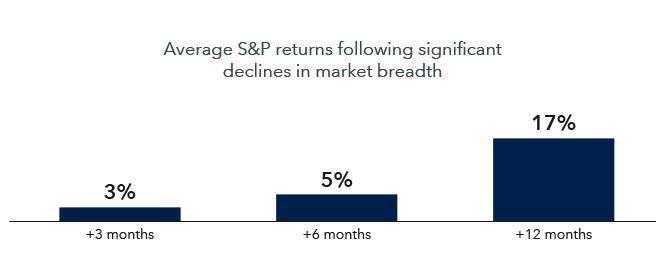Economic Indicators
Market Volatility
The humble potato is one of the more remarkable food crops. It’s hardy, fast-growing and can thrive in many environments. It’s nutritious — if a little starchy — and calorically dense. These traits made it a worldwide staple in pre-Industrial Revolution times. In many areas, it was the staple, a wonder food that was instrumental in staving off global hunger.
Then came the potato blight of the mid-19th century, which ripped through plant stocks in Europe for several growing seasons. Areas that had come to rely almost exclusively on the plant suffered greatly.
What does this have to do with investing? Quite a bit, as it turns out. The potato analogy demonstrates the danger of overrelying on anything, even something cherished for its past dependability or future promise.
That’s important to keep in mind when assessing this year’s stock market and the outsize influence wielded by a handful of giant technology stocks. Big Tech, of course, has dominated the market for much of the past quarter-century as the internet, smartphones and cloud computing flourished, but its grip tightened even further during the pandemic. Housebound consumers flocked to online shopping, personal videoconferencing and streaming television. Lately, artificial intelligence has stoked enthusiasm.
The result has been share-price surges in a small contingent of tech goliaths. These “Magnificent Seven” — Alphabet, Amazon.com, Apple, Meta, Microsoft, NVIDIA and Tesla — have come to hold so much sway that their direction can dictate the course of the index itself. Indeed, these businesses now make up 25% of the S&P 500 by weight — a higher level of concentration than during the late-1990s dot-com bubble. Collectively, they account for a whopping 84% of the index return this year.
The "Magnificent Seven" have an outsize impact on the market as a whole

Source: FactSet. Weighted values for Apple, Microsoft, Alphabet, Amazon, NVIDIA, Tesla and Meta. Contribution to return calculated period is January 1, 2023, through September 30, 2023. Past results are not predictive of results in future periods. As of September 30, 2023.
The most obvious risk: That tech can yank the market down with the same fury it drove it up. That was the case last year when several companies ran into business-specific obstacles. It’s happened to a lesser degree recently as rising interest rates weighed on the sector.
Of course, tech continues to have a lot going for it, including the tectonic potential of AI. Still, the sector is richly priced and the “Magnificent Seven” would have to grow a lot just to justify current valuations. Beyond that, history suggests that the Big Tech dominance may not persist, as past megacap rallies have been followed by stints of underperformance relative to the rest of the market.
Historically, concentrated markets have often been more volatile.
The Big Tech surge is challenging investors in ways the market hasn’t experienced in roughly 40 years. The Nasdaq 100 Index had to undergo a “special rebalance” in late July — only the third in its history — to address over-concentration and avoid breaching Securities and Exchange Commission rules on fund diversification.
Investors face numerous challenges when indices place so many eggs in so few baskets. Evidence suggests high concentration can increase overall portfolio risk, especially for passive investors, because it limits diversification. Balanced portfolios, by contrast, seek to avoid too much exposure to any single headwind while looking to benefit from many potential sources of growth.
The top quarter of the S&P 500 is heavily exposed to secular trends such as AI, augmented reality/virtual reality, autonomous vehicles and more. The top 20 stocks in the index are dominated by two sectors, communication services and information technology. The upshot: Despite their unique businesses and idiosyncratic characteristics, Big Tech stocks are exposed to common risk factors.
Diversification woes could extend to bonds as well.
If it weren’t enough that the diversification power of the equity portion of investor portfolios has eroded, the diversification typically achieved with a bond allocation is somewhat diminished as well. Since December 2012, over rolling 90-day periods, higher market concentration was associated with higher correlations between stocks and bonds. That means that, as markets became less diverse, stocks and bonds started to move in the same direction more often, undercutting the broader diversification benefits of a balanced portfolio. As a result, today’s concentration levels might mean investors may encounter more volatility than they’re prepared for.
Narrow markets do offer opportunities.
Fortunately, investors don’t have to feel trapped by a small handful of big stocks. Evidence suggests that narrow market rallies have often been followed by steady gains for the broader market. We analyzed the S&P 500 Index from both a market-weighted and an equal-weighted perspective, from 1997 through the end of the third quarter of 2023. Market-weighted indices have tended to lead in periods of high concentration because they magnify share price fluctuations in larger companies.
We found that in periods where “megacaps” were dominant — defined as when the market-weighted index led by 7 or more percentage points, which was the case at the end of the third quarter — that the equal-weighted index went on to lead by an average of 3 percentage points in the next year and an average of 5.4 percentage points per annum for the next three years. Services and funds that intentionally take a more conservative approach to these sometimes-volatile stocks have typically been well-served in such periods.
The S&P 500 Index has tended to rally after market concentration fell

Sources: Capital Group, Refinitiv Datastream, Standard & Poor's. Significant declines in market breadth are measured as dates upon which the ratio of the equal-weighted S&P 500 Index to the market-cap weighted S&P 500 Index falls below the first quintile of the total range between December 31, 2004, and July 5, 2023. Past results are not predictive of results in future periods. As of July 5, 2023.
Overall, today’s circumstances underscore the importance of ensuring that your portfolios are designed to meet your needs. As circumstances change, portfolios change with them. Your Private Wealth Advisor can speak with you any time to make sure your holdings remain in sync with your long-term plan.
S&P 500 Index is a market capitalization-weighted index based on the results of approximately 500 widely held common stocks. This index is unmanaged, and its results include reinvested dividends and/or distributions but do not reflect the effect of sales charges, commissions, account fees, expenses or U.S. federal income taxes.
The S&P 500 Index (“Index”) is a product of S&P Dow Jones Indices LLC and/or its affiliates and has been licensed for use by Capital Group. Copyright © 2023 S&P Dow Jones Indices LLC, a division of S&P Global, and/or its affiliates. All rights reserved. Redistribution or reproduction in whole or in part is prohibited without written permission of S&P Dow Jones Indices LLC.
Related Insights
Related Insights
-
-
-
Long-Term Investing

 Steve Fox
Steve Fox